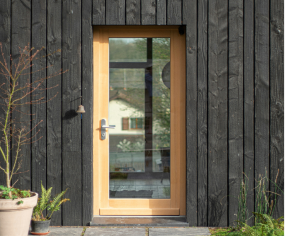Broadly speaking, the important criteria for choosing windows and external doors can be grouped as follows:
- energy values (U-value, solar factor, light transmittance, selectivity factor, air transmittance);
- design (product range, materials, finishes, partitions, special glazing);
- ventilation (window opening schemes, ventilation dampers);
- security (safety for the user, protection against intrusion, safety glasses, safety shutters);
- functionality (opening schemes, different locking options);
- Ease of use (heated packages, electric openings, special features such as a cat hatch in the doors, etc.);
- noise requirements (soundproof glazing);
- ecological applications (natural materials wood and aluminium, finishes);
- the budget matches the desired outcome.
Openings represent a significant part of the building’s budget. The risks are very high – the cheapest offer may not give the buyer the best end result. When dealing with different bidders, it is advisable to make sure that equivalent products and services are offered.
Optimal results require very good cooperation between the client, the designer and the manufacturer of the openings:
- It all starts with the owner’s wishes, which should be taken into account by the building’s designer;
- The next step is to have a professional sales team for the openings, and for more complex projects it makes sense to involve a technologist from the openings manufacturer;
- This is followed by a professional site survey by the installer and the final product specification, realistic budget and time schedules;
- The ability of both the manufacturer of the openings and the installer of the product to achieve a good result must be assessed equally.
The importance of the installation of openings has grown over the years
Today’s architecture favours light in buildings. Thermally insulating glazing and profiles are giving architects more and more freedom in terms of energy efficiency. As a result, openings have become much larger in size and heavier in weight. Today, windows and exteriors can be thought of as facade elements of a building, rather than windows in the classical sense. There are fewer and fewer external openings that can be installed by hand. As a result of the forklift trucks, the use of lifting equipment and the ability to deal with complex situations are both essential in modern installation work.
In addition, applications for energy efficiency in buildings have tightened the installation requirements for openings also in terms of thermal and wind performance. Different solutions, materials and techniques are used, which in turn make installation more complex, risky and professional.
Good openings without professional installation work will not give the desired end result. Unfortunately, this has also increased the budget for installation work.
Doors-windows ahead, what next?
If you want a good result and to maintain the quality of the products, you should definitely plan the construction in such a way that the building envelope is covered by a roof and the rooms are dry when the openings are made. Also, water-intensive work in the building (e.g. concrete pouring) is not acceptable after the installation of timber joinery products. Thoughtful planning of the work on site will have a significant impact on the success of the openings investment and the customer’s subsequent satisfaction with the product quality.
There is no need to worry too much in the first winter if the thermal imaging of the building does not give the desired result – building moisture in the building can cause heat leaks and condensation on openings. In Estonian conditions, a building needs one heating season to dry out the building moisture. Let’s live through one winter in a new house and the heat leaks will be gone by the next heating season.
Everything human-made needs care, including openings, where it is important to carry out adjustments and maintenance as necessary – locks and hinges need oiling from time to time, profiles and seals need cleaning, etc. If paint damage occurs, repairs should not be delayed. However, if a more serious problem should occur, the manufacturer should be contacted immediately for advice and assistance.
When is the right time to order window doors?
Sufficient time is needed. It takes 2 to 3 weeks for the customer and the manufacturer to work through the design, measure the object, and for the customer to decide and place the final order. For the production of openings, 4-6 weeks are needed, plus 1-2 weeks to fit in the installation schedule.
If you plan wisely, you could start the process of ordering window doors 9-10 weeks before the day you want the doors to open.
For the best price, place your order in January-February, when it’s a bit quieter.
Consumption in the wood products market is on a slight upward trend, with Aru Group’s volume growth last year exceeding 10%.
Aru Group is predominantly focused on the Dutch, Japanese, Irish, Danish and, to a lesser extent, Norwegian and Swedish markets. In addition to exports, we also try to serve private customers in Estonia who want to buy an open-plan fence, staircase or wooden house. If the buyer is interested in a good result and is willing to thoroughly prepare his project with us, we will find a way to offer and produce the best solution available today.
Understandably, a contracting authority not involved in construction on a day-to-day basis cannot and does not need to be familiar with the details of openings. I would like to encourage you to come and ask for advice! There are no ignorant questions when the aim is a good result.
Ask for an offer
Our experienced team is ready to bring your vision to life, whether it’s custom windows, doors, stairs or a house. We offer a professional approach to every project, ensuring a result that meets your exact needs.
To receive a quote, fill out the form and we will contact you!
